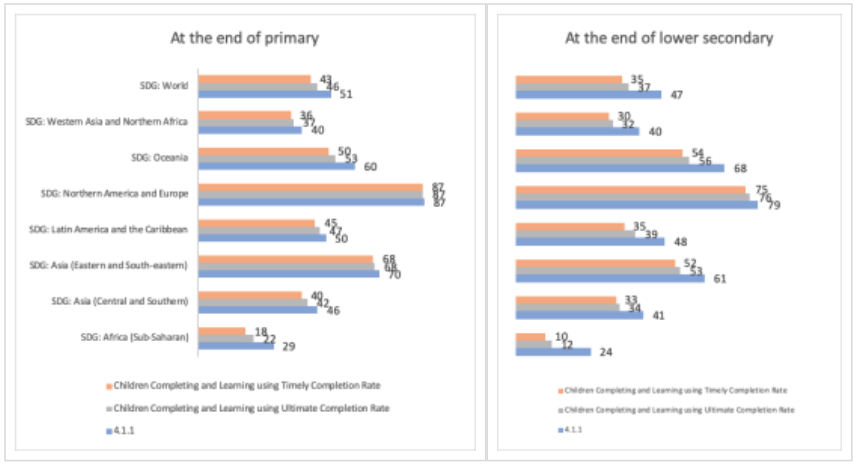By Silvia Montoya, Director, UNESCO Institute for Statistics (UIS) and Manos Antoninis, Director, Global Education Monitoring Report
The Sustainable Development Goal (SDG 4) for education recognizes that all children deserve, and have the right to, a quality education. Over the last three decades, enrollment has risen to historic highs, though school disruptions and the economic implications of COVID-19 will offset some of these gains. But enrollment is only a part of what children need. For children to be fully prepared for the future, they need to complete their education, and emerge having learnt at least the basics. The new global indicator will combine all these critical factors to provide a snapshot of progress towards SDG 4.
Unfortunately, in some of the poorest regions where children are most in need of a high-quality education to get ahead, poor learning outcomes often result in higher drop-out rates with large numbers of children not completing school at all – or completing it when more than five years older than the intended graduation age for that level. In sub-Saharan Africa, for example, where 82% of primary aged children are enrolled in school at the right grade for their age, just 62% graduate from this level on time. When children don’t finish school, it is hard, if not impossible, for any more learning to happen.
Even where education is free, poor families still pay for books and uniforms, and there is the perceived “opportunity cost” of lost income or help with household chores, while children are in school. If parents don’t see a pay-off from their investment in education, children can be pulled out of school before completing a level, or when transitioning between levels, from say, primary school, to lower secondary.
To underline the need for countries to prioritize school completion, the UNESCO Institute for Statistics (UIS), working through the Global Alliance to Monitor Learning (GAML), is proposing a new, holistic, indicator that will track both completion and learning combined. The aim is to ensure that global leaders and education policy makers have the evidence they need to zero in on where they stand on their SDG 4 commitments. With ten targets and 42 indicators in the monitoring framework for SDG 4, some might argue that it is hard to quickly grasp where countries stand in their progress towards the goal. With so many touch-points, it risks calls for change being watered down. This new indicator will hopefully answer these concerns, providing a simple rallying reference point for all education actors to lobby for improvement, ensuring all children are prepared for the future.
The focus in SDG 4 on the quality of education is encapsulated in Target 4.1 which combines the joint objective of enrollment and learning by asking all countries to “ensure that all girls and boys complete free, equitable and quality primary and secondary education leading to relevant and effective learning outcomes” by 2030.
To measure the success of Target 4.1 and the overall quality of education, Indicator 4.1.1 considers learning outcomes and is defined as the “proportion of children and young people (a) in Grade 2 or 3; (b) at the end of primary education; and (c) at the end of lower secondary education achieving at least a minimum proficiency level in (i) reading and (ii) mathematics, by sex.”
In March 2020, a new measure, Indicator 4.1.2, was approved and included in the SDG 4 Global Framework to address school completion. It is defined as: “completion rate (primary, lower secondary education, upper secondary education,” or the percentage of a cohort of children who have completed a given education level.
The new indicator we are proposing today, Prepared for the Future combines these two elements and is defined as the proportion of children (a) reaching grade 3, (b) completing primary and (c) completing lower secondary and achieving minimum proficiency in (i) mathematics and (ii) reading, at the respective levels, by sex.
This new combined indicator is measured by looking at the proportion of the school-age population completing school and whether or not they have achieved the minimum learning proficiency for their grade as defined by GAML. It looks at timely and ultimate completion, which have been calculated by the GEM Report. These differentiate between children who may complete education levels up to 3 or 5 years later than the official graduation age, which can be defined as timely completion, and the children who complete even later than that, which can be defined as ultimate completion.
It shows, for instance, that at most 43% of children are completing primary school and learning worldwide, falling to only 18% in sub-Saharan Africa. At most 34% are completing lower secondary education and learning, falling to just 10% in sub-Saharan Africa. If we want our children to be prepared for the future, we have much work to do.

Source: UIS based on UIS database for indicator on Indicator 4.1.1 and GEM Report estimates for indicator on timely and ultimate completion
When compared with Indicator 4.1.1, it is clear that the new, comprehensive indicator which includes learning AND completion, presents a more realistic view of the challenges ahead, particularly in areas with high drop-out rates. In sub-Saharan Africa, for example, while Indicator 4.1.1 shows that 29% of primary aged children are meeting learning objectives, the new indicator reveals that, due to high drop-out rates, only 18% are prepared for the future. On the other hand, in Eastern and South-eastern Asia, the difference between the two indicators is less pronounced (especially at the primary level) due to the fact that drop-out rates are far lower.
To be fully prepared for the future, it is not enough for children and adolescents to simply be sitting in a classroom. They must be learning, and they must complete school to get the full benefits of the investment their families make. Our new indicator shines a light on where we stand and points to where we need to be to fulfill children’s right to quality education.
Leave a comment